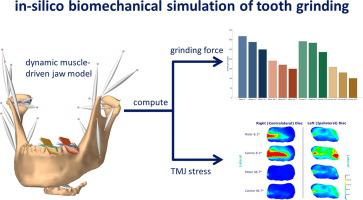Journal of Advanced Research ( IF 10.7 ) Pub Date : 2021-04-29 , DOI: 10.1016/j.jare.2021.04.009 Benedikt Sagl 1 , Martina Schmid-Schwap 1 , Eva Piehslinger 1 , Michael Kundi 2 , Ian Stavness 3

|
Introduction
Functional impairment of the masticatory region can have significant consequences that range from a loss of quality of life to severe health issues. Increased temporomandibular joint loading is often connected with temporomandibular disorders, but the effect of morphological factors on joint loading is a heavily discussed topic. Due to the small size and complex structure of the masticatory region in vivo investigations of these connections are difficult to perform.
Objectives
We propose a novel in silico approach for the investigation of the effect of wear facet inclination and position on TMJ stress.
Methods
We use a forward-dynamics tracking approach to simulate lateral bruxing on the canine and first molar using 6 different inclinations, resulting in a total of 12 simulated cases. By using a computational model, we control a single variable without interfering with the system. Muscle activation pattern, maximum bruxing force as well as TMJ disc stress are reported for all simulations.
Results
Muscle activation patterns and bruxing forces agree well with previously reported EMG findings and in vivo force measurements. The simulation results show that an increase in inclination leads to a decrease in TMJ loading. Wear facet position seems to play a smaller role with regard to bruxing force but might be more relevant for TMJ loading.
Conclusion
Together these results suggest a possible effect of tooth morphology on TMJ loading during bruxism.
中文翻译:

磨牙症期间小面倾斜和位置对 TMJ 负荷的影响:计算机研究
介绍
咀嚼区域的功能障碍可能会产生严重的后果,从生活质量下降到严重的健康问题。颞下颌关节负荷增加通常与颞下颌关节紊乱有关,但形态因素对关节负荷的影响是一个被广泛讨论的话题。由于咀嚼区域的小尺寸和复杂的结构,这些连接的体内研究很难进行。
目标
我们提出了一种新的计算机方法来研究磨损面倾斜和位置对 TMJ 应力的影响。
方法
我们使用前向动态跟踪方法来模拟尖牙和第一磨牙的侧磨牙,使用 6 种不同的倾斜度,总共有 12 个模拟案例。通过使用计算模型,我们在不干扰系统的情况下控制单个变量。报告了所有模拟的肌肉激活模式、最大磨牙力以及 TMJ 椎间盘应力。
结果
肌肉激活模式和磨牙力与先前报道的 EMG 发现和体内力测量非常吻合。模拟结果表明,倾斜度的增加会导致 TMJ 负荷的减少。磨损面位置似乎对磨牙力的影响较小,但可能与 TMJ 负荷更相关。
结论
总之,这些结果表明牙齿形态对磨牙症期间 TMJ 负荷的可能影响。


























 京公网安备 11010802027423号
京公网安备 11010802027423号